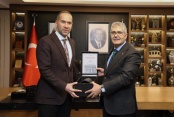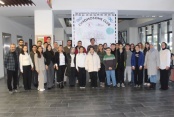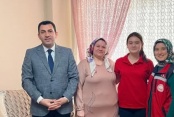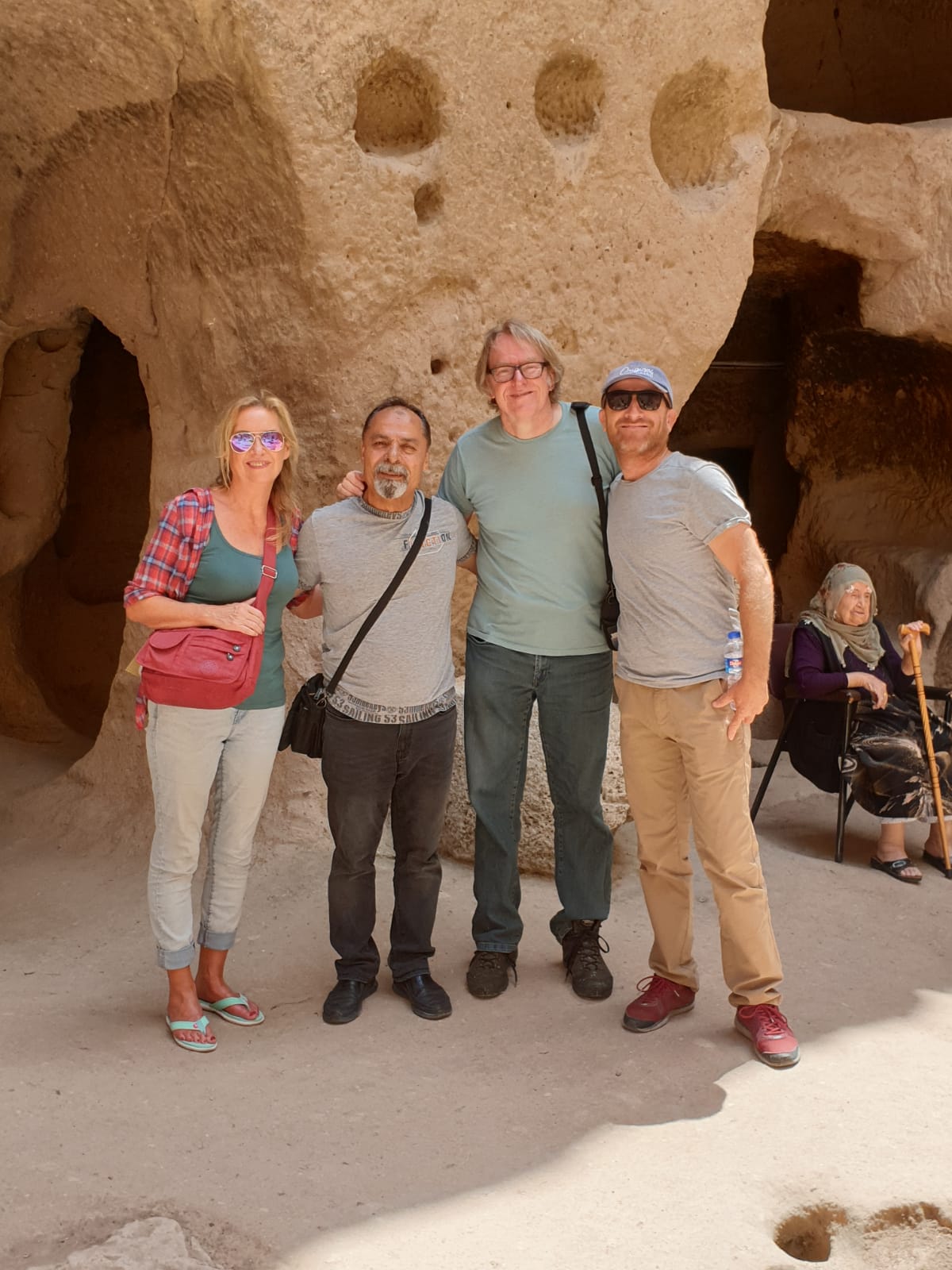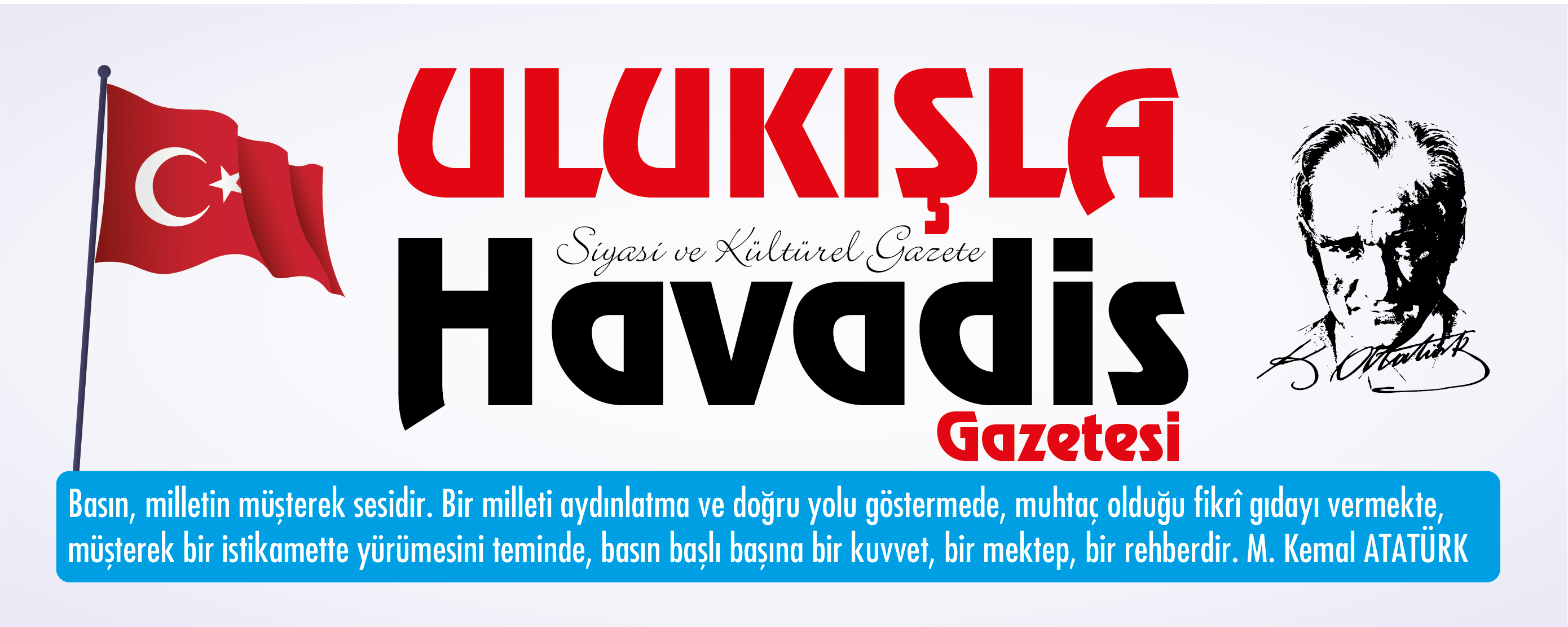F. Tan: Merhaba. Sizi tanıyabilir miyiz?
Ed Hanssen: Benim adım Ed Hanssen. Hollanda'nın Nunhem şehrinde yaşıyorum. Resim yapıyorum, çiziyorum, mailart yapıyorum, küçük heykeller, enstalasyonlar, videolar (tek başına ve Carmen Heemels ile HHAP olarak) yapıyorum ve Genuine Art Projects internetional (eski adı: Gogyoshi Art Project int) GAPI), projectmailartbooks, coffeeefiltermail gibi sanat projeleri, otoportre çizim topluluğu ve projeleri gerçekleştiriyorum. Çalışmalarımı çoğunlukla ahşap bir bahçe evi olan stüdyomda yapıyorum. Web sitelerimi www.edhanssen.exto.nl ve www.projectmailartbooks.com ziyaret edebilirsiniz.
F. Tan: Alaylı mı? Bir sanat okulundan mısınız?
Ed Hanssen: İlk olarak 12 yaşımdayken çizmeye başladım. Okulda diğer çocuklara kıyasla oldukça iyi resim çizdim, ama çizime olan aşkımı da kaybettim. Neyse ki benim için geri döndü. Annem bana bir kutu boya verdikten sonra yağlı boya resim yapmaya başladım. Kısa bir süre sonra bir sanatçıdan ders aldım. Beni yaşamdan sonra figür çizme ve resim yapma modeliyle tanıştırdı. O kadar sanata girdim ki sanat akademisine ve heykeltıraşlık kursuna hazırlanmak için bir kursa girdim. Bu büyük bir zevkti. 1995'te Maastricht sanat akademisine girdim. Eve dönüş gibiydi. Hala koridorların, sınıfların, sanat derslerinin kokusunu alabiliyorum, işten eve ve doğrudan sanat akademisine gidiyorum ve düşüncelerimi o dersi yapmak üzere olduğum şeye, sanat öğretmenlerime ve onların sanat hakkındaki fikirlerine ve ne kadar uzakta onlar bu konuda birbirlerini oluşturdular. Almanya'nın Köln kentinde ve İspanya'nın Barselona kentinde düzenlenen sergi gezilerini hâlâ hatırlıyorum. Bazı öğrencilerin birbirleriyle çekişmeleri vardı. Gözümden köşeden bakarken bazı renklerin birlikte çalıştığını gördüğümde hissettiğim heyecanı hala hissediyorum. Sanat akademisindeki 5 yılımı gerçekten çok beğendim. Evimden uzaktaki evimdi.
F. Tan: İşinizde hangi teknikleri kullanıyorsunuz?
Ed Hanssen: Eserlerimde en çok kullandığım teknik, akrilik boya ve duvar boyası katmanlarında çalışmak ve üzerine tebeşir ve/veya karakalem ile çizim yapmak. Bazen resimlerimde ve çizimlerimde kolajlar bulabilirsin. Karakalem, pastel, keçeli kalem, çini mürekkebi, kurşun kalemle çiziyorum. Eskiden yağlı boyayla resim yapardım ama ortaya çıktığında pek kafamı sarmadı ve bu yüzden akriliğe döndüm.
F. Tan: Pandemi (Covid 19) sürecinde sanatsal faaliyetlere katılabildiniz mi? Covid 19 sizi ve çevrenizi nasıl etkiledi?
Ed Hanssen: Gündüz işim nedeniyle yapmak zorunda olduğum tam zamanlı bir kurs nedeniyle, Covid-19 sırasında sanat benim için biraz daha az önem kazandı. Bunun için çok üzgünüm ama kurs şimdi bitti, bu yüzden tekrar tam gaz gidebilirim.
Kovid19. Daha önce hiç tanık olmadığımız kadar büyük bir salgın. Pek çok insanın yaşamı üzerinde yıkıcı etkisi oldu. Hayal etmesi zor. Kilitlenme ve sokağa çıkma yasağı. Biz buna alışık değildik. Ama benim için bu bir lütuftu! Benim için barış zamanıydı ve hala da öyledir. Ofiste çalışmak yerine evde çalışmayı seviyorum. Covid-19'un bize getirdiği rahatlığı seviyorum. Kilitlenmeyi seviyorum, çünkü insan kendi kendine geri dönüyor. Her şeyin bitmesini ve hepimizin normale dönmesini gerçekten istemem eskiden olduğu gibi normal. Restoranlara, ofise, mağazalara randevusuz, her gün işe gitmek için arabamı sürmeyi özlemiyorum. Sokağa çıkma yasağından sonraki akşam bırakmayı seviyorum. Pek çok insanın bu konuda benimle aynı fikirde olmadığını biliyorum ve bu tamamen sorun değil. Doğru olmayan, Covid-19'u görmezden gelen ve bunun sadece bir baca olduğunu düşünen ve her türlü komplo teorisine sahip kişilerdir. Bu insanları hayal edemiyorum ama varlar.
F. Tan: Ülkenizde sanata ve sanatçıya bakış açısı nedir?
Ed Hanssen: Hollanda'daki Covid-19 sanatı ve dünyanın geri kalanının çoğu darmadağınık durumda. Online sergiler dışında sergi yok, hiçbir şey yok. Yani şu anda etrafta dolaşılacak pek gerçek sanat hayatı yok. Covid-19 bittiğinde ve bir gün bitecek sanat tam güçle geri dönecek. Bundan eminim. Sanat eserlerini, galerileri ve müzeleri tekrar görmeye gideceğim, itiraf etmeliyim ki bu salgın sırasında onları kaçırmıyorum.
F. Tan: İnsanlar sanatçıyı nasıl görüyor? İnsanların sanata bakışından memnun musunuz?
Ed Hanssen: Sanatçı Hollanda'da pek iyi karşılanmıyor. Pek çok insan bunun solcuların hobisi olduğunu düşünüyor. Bu yüzden bazen birçok sanatçı için bir mücadele. Belki bunun belirli sağ kanat siyasi partilerin yükselişiyle bir ilgisi vardır, bilmiyorum. Ama uzun zamandır bu böyleydi. Galeriler sayı olarak zayıflıyor. Hükümet tarafından sübvanse edilmesi kolay değil. Hollanda'da sanat yeryüzü cenneti değildir, aşağıda da cehennem değildir. Hollanda dışından birçok insanın hala Hollanda'nın sanat cenneti olduğunu düşündüğünü biliyorum.
F. Tan: Bir sanatçı olarak, sanatınızı ve kendinizi gelecekte nerede görüyorsunuz?
Ed Hanssen: Gelecekte sanatımı ve kendimi nerede göreceğim zor bir soru. Sanat eserimi dünyanın her yerindeki büyük müzelerde değil, daha küçük müzelerde asılı görüyorum…. Bu zaten oldu. Öyleyse geleceğin neler getireceğini kim bilebilir, ama hiç umudum yok. Geldiği gibi alıyorum. Bu çok sinir bozucu değil. Bazılarının ziyaretçilerle güzel tartışmalara yol açtığı pek çok resim yaptığım için, pek çok insanın katıldığı fikirler ürettiğim için şimdiden çok şanslıydım. Bu zaten onu değerli kıldı. İnsanlarla sanat yoluyla tanışmak, yerlere gitmek. Sanatım farklı yerleri ziyaret ederken, umarım ki ben de öyle düşünüyorum ve şimdiye kadar sanatım bana daha önce hiç gitmediğim veya oraya gitmeyi hayal etmediğim yerleri gösterdi. İşin güzel yanı, hepsi harika yerler, hepsi harika insanlar ve harika deneyimler.
F. Tan: Çalışmalarınızda en çok hangi temayı kullanıyorsunuz?
Ed Hanssen: Temalara göre çalışmayı seviyorum, her zaman değil, ancak sık sık sessizce. Geçmişte demans / Alzheimer, kanser üzerine çalıştım ve şimdi bu ilişkiler. Hepsi o dönemde hayatımda olanlarla örtüşüyor. Mailartımda birçok farklı tema kullanıyorum.
F. Tan: Sanatın insanlar üzerindeki gücüne inanıyor musunuz?
Ed Hanssen: Sanat güçtür. Sanat insandır. İnsanlar sanattır. Sanat insanlar tarafından yaratılıyor ve belli bir gücü var. Bu güç insanları gülümsetebilir, ağlatabilir, heykeltraşlık, resim, çizim, gravür, performans, düşünmeye başlamaları için onlara ilham verebilir. Sanatın belki de en büyük gücü, sanatın ne kadar büyük ya da küçük olursa olsun bir şeyleri değiştirme gücüne sahip olmasıdır. Tek gereken açık fikirli olmak ve sanat eserleri üretmek.
F. Tan: Her çocuğun sanata yönlendirilmesi gerektiğini düşünüyor musunuz?
Ed Hanssen: Her çocuk kendisine neyin ilham verdiğini bulmalıdır. Sanat onlara ilham verecek ve beni çok mutlu ve gururlu hissettirecek bir şey. Ancak spor yapmak, matematik yapmak, bilgisayar teknolojisi yapmak veya evler inşa etmek için ilham alırlarsa, bu da harika olurdu, çünkü tüm çocuklara ihtiyacımız var. Gelecekteki çalışmalarında da yaratıcı olabilirler. Okulda tüm çocuklara sanat öğretilmeli, sadece teori değil, el işi, yaratıcılık, özgürlük, fikirler ve hayallerini ve fikirlerini mümkün olan her şekilde doldurmaya çalışmak. Sanat, çocukları sadece yaratıcı değil, aynı zamanda kendileri için de düşündürüyorsa, ilerideki yaşamlarında da yardımcı olacaktır.
F. Tan: Çocukların ve gençlerin sanatınıza bakış açısı nedir?
Ed Hanssen: Zor bir soru. Bazıları “Hey, onu bende yapabilirim!" çünkü kolay görünüyor. Öyleyse o çocuk veya bu çocuklar kendi ifade tarzlarını bulmuş olabilirler. Öyleyse çok memnun olurum. Art Niğde’nin Artquake sergisinin yaklaşan sergilerinden birinde test etmek güzel bir fikir olabilir mi?
F. Tan: Toplumun gelişmesiyle sanat arasında bir bağlantı olduğunu düşünüyor musunuz?
Ed Hanssen: Elbette toplumun gelişimi ile sanat arasında bir bağlantı var. Sanat tarihine bakın ve sorunun cevabına sahipsiniz. Toplum, sanat yaratmak için sanatçıları görevlendirdi. Romalılar ve Yunanlılar ilk günlerinde, Rönesans döneminde İtalya'daki ünlü aileler, Altın Çağ'ın zengin tüccarları olan Barok dönem zengin kraliyetinin anlamsızlığı ve aşırılığı, sanat eserlerini boyut olarak daha erişilebilir hale getirdi. Romantizm, düşüncelerini ve davranışlarını yakalamak için insanların beynine bakma fikrini verir. Sanayileşme bize birçok şeyin yanı sıra tüplerdeki yağlı boyayı da verdi. Sanatçıları eskisinden çok daha fazla dışarıda resmettiren izlenimcilik, sanayileşmenin ve resmetmenin harika bir örneğidir. Her şeyi sorgulayan kübizm, tıpkı Dada'nın yaptığı gibi, ilk kez ready-made'ler sanat haline geldi, fütürizm esir hareketine dönüştü çünkü arabalar geldi 2.Dünya Savaşı'ndan sonraki dönem bize sadece dünya barışını ve özgürlüğü değil, aynı zamanda soyut dışavurumculuğu da verdi: özgürlük için bir çıkış yolu büyük tuvallerde ve her türlü malzeme ile kendini ifade etme sanatı. Ekonomiler büyüdükçe ve büyüdükçe ve insanların satın alabilecekleri çok şey olduğu için bu Pop Art'a dönüştü. Altmışların ana renklerine yanıt olarak yetmişlerin ikincil renkleri. Yetmişlerin “duygusuz” özetlerine yanıt olarak seksenlerde dışavurumculuğun yeniden canlanması. Graffity gibi streetart ile sanata giriş. Yeni dışavurumculuğa bir cevap olarak kısa ömürlü Neo-Geo.
Bütün -izmler, içinde bulundukları dönemle örtüşür. Hepsi bir önceki döneme ve kendi dönemine bir cevap ya da tepkidir. Fikirler sarsıldı, test edildi ve tekrar tekrar sorgulandı. Sanat toplumu olduğu gibi temsil eder ve onu sorgular. Bir gün gelecek bize bu anın sanat için ne anlama geldiğini anlatacak.
F. Tan: Bir resim yapılırken sizde ve tuvalde nasıl bir macera yaşanıyor?
Ed Hanssen: Resim serüveni, bazen ne yapacağımı bildiğimi düşünüyorum, sadece sonucun çok sık farkına varmak hayal kırıklığı yaratıyor. Yapabileceğim tek şey aniden bir şekilde araya girmek. Her şeye yeniden başlayın veya bir parçanın veya bütünün üzerini boyayın. Bazen tek seferde yapılması iyi sonuç verir, ancak çoğu zaman işe yarar. Ama sonradan ödüllendirici, çünkü sonuçtan gurur duyuyorum ve memnunum. Bazen bu sadece bir gün sürer, sadece düşünmek ve resim reklamını tekrar ziyaret etmek: " hiç iyi değil ..." Sonuçta bunu her zaman görmemekle birlikte, bu bir mücadeledir. Yeniden düşünmenizi, tepki vermenizi sağlarlar. Sonuç planlanandan tamamen farklı bir şey olabilir. Bu parçaları ben de seviyorum. Hataları kabul etmek harikadır, çünkü onları tanıyorsunuz ve buna göre hareket edebiliyorsunuz, kullanabiliyorsunuz. Genel olarak bir resim ya da sanat eseri, sadece güzel olmak ya da insanları mutlu etmekten başka, bir mesajı da olmalıdır. Umarım sanat eserleri insanların kendilerini veya benim sanat eserimi sorgulamasına neden olur. Resme bakan kişi ile resmin kendisi arasındaki konuşma. Bir sanat eseri bir şekilde kişisel olmalı.
F. Tan: Niğde hakkında ne biliyorsun?
Ed Hanssen: Niğde…. Doğruyu söylemek gerekirse Safa Büte'yi duyana kadar hayatımda Niğde'yi hiç duymamıştım. Hatta bazı tanıdığım Türkler ve hiçbirinin Niğde hakkında bir şey bilip bilmediğini sordum. O kadar komik ki şimdi Niğde hakkında tanıdığım bazı Türklerden daha fazla şey biliyorum. Ama Niğde hakkında ne biliyorum derseniz, modern / Batılı bir his uyandırdığını biliyorum. Büyük bir küçük el sanatları endüstrisi bölümüne sahiptir. Büyük caddelerden birinden Niğde'yi çevreleyen dağlara muhteşem bir manzaraya sahiptir. İkisini ziyaret ettiğimiz, biri Niğde'yi çok iyi gören çok sayıda cami var. Cumartesi akşamı gezintisini hatırladığım, lezzetli yerel hamur işleri ve dondurma yiyip elma çayı içtiğim için hayat dolu bir şehir. Niğde'ye misafir olmak bir zevkti ve çok hoş karşılandım.
F. Tan: İleride Niğde'ye gelmeyi düşünüyor musun?
Ed Hanssen: İleride Niğde'ye gelmeyi çok isterim. Niğde'ye giden eski otobanı, güzel ahşap tavanlı oteli, geceleyin güzel elma çayları, lezzetli Türk kahvesi ile kafeyi, tatlı sıcaklığı, küçük sokaklarda futbol oynayan çocukları, küçük dükkanları hatırlıyorum. Dükkanlarının önündeki tüm kapıları harika yaşlılar, Niğde'nin diğer tarafındaki metal işçileri, camiler, eski bir cami galerisi, Artquake sergisinin açılışındaki ziyaretçi sayısı, çevresi ve tabii ki Safa Büte ve bize birkaç gün etrafı gezdiren Mustafa Eryaman. Niğde kesinlikle tekrar ziyaret etmek istediğim bir yer.
F. Tan: Türkiye hakkında ne düşünüyorsun? Daha önce geldiniz mi?
Ed Hanssen: Bence Türkiye, çok sayıda harika şehir ve site, dağlardan muhteşem manzaralar, güzel yiyecek ve içecekler ve en önemlisi Türkiye'nin büyük ve gururlu insanları ile harika bir ülke: çok arkadaş canlısı. Bir kez olsun hoş karşılanmadığımı ya da güvensiz hissetmedim. Nerede olursam olayım bir zevkti.
İran'a giderken İstanbul'u ziyaret ettim. İstanbul'da kısa bir konaklamaydı ama unutulmaması gereken bir şehirdi. Boğaz'ı geçmek, Sultanahmet Camii'ni ziyaret etmek, sabah sessizlik, başıboş köpekler, bir lokantanın tepesinde elma çayı, gündüz işlek sokaklar. Canlı İstanbul göz, kulak, burun ve ağız için bir keyifti. Ama ayrıca Niğde, Samsun, Adana ve başka bir Türkiye gezisinde gittiğim daha pek çok yer çok güzel.
F. Tan: Türkiye'de en çok görmek istediğiniz şehir neresi?
Ed Hanssen: Bir kez İstanbul'a gittim ve Niğde'yi ziyaret ettiğimde Ankara, Ügrüp, Samsun, Adana, Sivas ve daha birçok kasaba ve şehri ziyaret ettim. Sanırım hepsini tekrar gözden geçirmek istiyorum, çünkü hepsi çok güzel. Tıpkı ziyaret etmesi gerçekten harika olan minik köyler gibi. Ziyaret etmemeyi tercih ettiğim yerler daha çok turist tarafından ziyaret edilen yerlerdir. Çünkü Hollanda yemeği yiyor ve her zaman Hollandaca konuşuyor olabilirim. Türkiye'yi veya bu konuda başka bir ülkeyi ziyaret ettiğimde peşinde olduğum şey bu değil. Türkiye’nin otantik insanlarıyla, otantik şehirleriyle tanışmayı seviyorum, sadece turistik yerleri değil, her ne kadar harika olsalar da. Bazı camileri, bir tatlı su kaynağını, dağlarda bir yazlık evi ziyaret ettiğimi hatırlıyorum… Hepsi harika! Belki bir dahaki sefere daha çok doğuya ve kuzeye seyahat ederdim, kim bilir.
F. Tan: Bir sanatçı gözünden bize konumunuzdan (şehriniz, köyünüz veya ilçeniz) bahseder misiniz?
Ed Hanssen: Doğduğum ve hâla yaşadığım küçük kasabanın adı Nunhem. Nunhem, Hollanda'nın en güney bölgesi olan Limburg bölgesinde yer almaktadır. Roermond, Venlo ve Weert gibi yakın şehirler. Nunhem, Leudal ilçesinin bir parçasıdır. "Leu" bir nehrin adıdır. "Dal" bir vadidir. Lütfen bizim dağlarımız ve vadilerimiz olduğunu düşünmeyin, çünkü bizde yok, bazı dik tepelerin bulunduğu ilin çok güneyinde. Leudal, aynı zamanda yürümeyi sevdiğim ve çocukken, günümüzde hala çocuklar gibi çokça oynanan, oldukça küçük bir doğa parçasının adıdır. Nunhem "yeni ev" anlamına gelir ve tarihi 1224 yılına kadar uzanır. Nunhem, +/- 1000 nüfuslu, huzurlu, sessiz bir küçük köydür. Bir kilisesi ve bazı kafeleri var ama dükkan yok. Aynı zamanda tohum konusunda çok uluslu bir şirkete sahiptir. Tohum ıslah şirketi (bezelye, domates, havuç vb.) olarak dünyada beş numaradır.
Röportajımızın İngilizcesi
F. Tan: Hello. Can we get to know you a little bit?
Ed Hanssen: My name is Ed Hanssen. I live in Nunhem, the Netherlands. I paint, draw, do mailart, make small sculptures, installations, videos (solo and as HHAP with Carmen Heemels) and initiate artprojects such as Genuine Art Projects internetional (formerly known as: Gogyoshi Art Project int) GAPI), projectmailartbooks, used coffeefiltermail art, selfportrait drawing community and many others. I create my artwork mostly in my studio, which a wooden gardenhouse. You can visit my websites www.edhanssen.exto.nl and www.projectmailartbooks.com.
F. Tan: Are you a self-educated artist? Or from an art school?
Ed Hanssen: First I started drawing when I was about 12 years old or so. At school I drew rather well, compared to the other kids, but than I lost my love for drawing. Luckily for me it returned. I started painting oilpaintings after my mother gave me a box of paint. Shortly after that I took up lessons from an artist. He introduced me to figuredrawing and painting after life model. I got so into art that I got into a course to get ready for the art academy as well as a sculptingclass. That was such a joy. In 1995 I entered the artacademy Maastricht. It felt like a homecoming. I can still smell the hallways and the classrooms, the artclasses, me driving from work to home and straight to the art academy and turn my thoughts into what I was about to do that lesson, my artteachers and their ideas about art and how far away form eachother they were on that subject. I still remember the arttrips to exhibitions in Köln, Germany and Barcelona, Spain. There was the rivalry some co-students had with each other. I still feel that thrill how I felt when I saw certain colours work together while looking from the corner from my eye. I really liked my 5 years at the art academy. It was my home away from home.
F. Tan: Which techniques do you use in your works.
Ed Hanssen: The technique I use most in my works is working in layers of acrylic paint and wallpaint and drawing over it with chalk and/or charcoal. Sometimes you can find collages in my paintings and drawings. I draw with charcoal, pastels, markers, indian ink, pencils. I used to paint with oilpaint, but as it turned out, my stomach didn’t agree wih that, so I turned to acrylics.
F. Tan: Have you been able to participate in artistic activities during the pandemic (Covid 19) process? How did Covid 19 affect you and your environment?
Ed Hanssen: Due to a fulltime course I had to do because of my daytime job, art got a little less important for me during Covid-19. So sorry for that, but the course is done now, so I can go full steam ahead again.
Covid-19. A pandemic so big, we have never witnessed before. It has had devastating effect on so many peoples lives. It is hard to imagine. Lockdowns and curfew. We were not used to that. But…… to me…… it was a blessing! It was (and still is) a time of peace for me. I love working at home, instead of working at the office. I love the quitness Covid-19 brought us. I love the lockdown, because one gets thrown back to oneself. I really wouldn’t like it when it is all over and we are all back to “normal” (normal as it used to be). I do not miss going to restaurants, to the office, to stores (without appointment), driving my car day in-day out to go to work. The quitness in the evening after curfew, I like it. I know not many people agree with me on this issue and that is perfectly allright. What is not allright is the people who ignore Covid-19 and think it is just a flue and who have all kinds of conspiracy theories. I just cannot imagine these people, but they exist.
F. Tan: What is the perspective of art and artist in your country?
Ed Hanssen: Due to Covid-19 art in the Netherlands, and much of the rest of the world, lies in shambles. No exhibitions, no nothing, except fort he online exhibitions. So there is not much real life art to go around right now. When Covid-19 ends (and it will end one day) art will return full force. I am sure about that. I will go see artvenue’s and galleries and museums again, although I must admit, I do not miss them during this pandemic.
F. Tan: How do people view the artist? Are you satisfied with people's view of art?
Ed Hanssen: Artist are not all very well received in the Netherlands. A lot of people have the idea it is just a lefties hobby….. so that is a struggle sometimes for a lot of artists. Maybe this has something to do with the rise of certain rightwing political parties, I do not know. But it has been this way for a long time. Galleries are slimming down in numbers. It is not easy to be subsidiced by the governement. Art in the Netherlands is not heaven on earth, not hell below either. I know many people from outside the Netherlands still do think the Netherlands is paradise for art: it is not.
F. Tan: As an artist, where do you see your art and yourself in the future?
Ed Hanssen: Where do I see my art and myself in the future, is a tough question. I do not see my artwork hanging in the big museums all over the world, but in smaller museums…. That already happened. So who knows what the future might bring, but I don’t have my hopes up. I take it as it comes. That is not so nerve wrecking. I have already been so lucky coming up with ideas many people joined in on, having painted so many paintings of which some lead to beautiful discussions with visitors. That already made it worthwhile. Meeting people trough art, going places. As my art visits places, so do I, I hope, and so far my art showed me places I had never been before or dreamed of going there. The nice thing is: they are all great places, all great people and all great experiences.
F. Tan: Which theme do you use most in your works?
Ed Hanssen: I like working by themes, not always, but quiet frequently. In the past I worked on dementia/Alzheimer, cancer and now it is relationships. They all coincide with what happens in my life in that period of time. In my mailart I use many different themes.
F. Tan: Do you believe in the power of art over people?
Ed Hanssen: Art is power. Art is people. People are art. Art is being created by people and it has a certain kind of power. That power can make people smile, it can make them cry, it can inspire them to take up sculpting, painting, drawing, etching, performing, think. Art’s greatest power maybe is that art has the power to change things, no matter how big or small. All it takes is an open mind and an artwork.
F. Tan: Do you think every child should be directed to art?
Ed Hanssen: Every child should find out what inspires them. Art is one thing that might inspire them and that would make me feel very happy and proud. But if they are inspired to do sports, mathematics, computertechnology or building houses, that would be great too, for we need all children. They can be creative in their line of future work too. At school all children should be taught about art, not just theory, but most of all the handwork, the creativity, the freedom, the ideas and trying to fullfill their dreams and ideas in any way possible. If art can make children not just creative but also think for themselves, it will help them in their further life.
F. Tan: What is the perspective of children and young people to your art?
Ed Hanssen: A tough question. Some might say “Hey, I can do that too!” because it looks easy. Well, if so. That child or these children may have found his/her/their way of expression. If so. I would be very pleased. Maybe a nice idea to test in one of the upcoming exhibitions of Art Nigde’s Artquacke?
F. Tan: Do you think there is a connection between the development of society and art?
Ed Hanssen: For sure there is a connection between the development of society and art. Look at arthistory and you have the answer to the question. Society appointed artists to create art. The Romans and Greeks in their heighdays, the famous families in Italy during the Renaissance, the frivolity and excess of the wealthy royalty of the Baroqueperiod, the rich merchants of the Golden Age made artwork more accessible in size. Romanticism gaves the idea of looking inside humans brain to capture their thoughts and behaviour. Industrialisation gave us among many other things, oilpaint in tubes. That made artists paint outside much more than before and impressionism is a great example of industrialisation and painting plein aire. Cubism that questioned everything, just like Dada did, and fort he first time readymades became art, futurism captioring movement because cars came around The period after World War 2 gave us not only worldpeace and freedom, but also abstract expressionism: an outlet for freedom in art to express themselves on huge canvasses and with all kinds of materials. This turned into Pop Art as economies grew and grew and people had so much things they could buy. The secundary colours from the seventies as an answer to the primary colours of the sixties. The revival of expressionism in the eighties as an answer to the “emotionless” abstracts of the seventies. The introduction to art by streetart like graffity. The shortlived Neo-Geo as an answer to the new-expressionism.
All the -isms coincide with their period in which they were. All are an answer or reaction to the period before and to the period of itself. Ideas were shaken, tested and questioned over and over again. Art represents society as it is and questions it. One day future will tell us what this moment in time meant for art.
F. Tan: What kind of an adventure takes place in you and on the canvas while a painting is being created?
Ed Hanssen: The adventure of painting….. Sometimes I think I know what to do, only realising the outcome very often is disapointing. The only thing I can do than is to abruptly intervein somehow. Start all over again, or paint over a part or the whole. Sometimes it works well having it done in one take, but most of the time it is work. But afterwards it is rewarding, for I am proud and satisfied about the outcome. Sometimes that only takes one day, just to think and revisit the painting ad saying: “it is not good at all….” So a struggle it is, although one will not always see that in the endresult. Accidents can be quit refreshing as well. They make you rethink, react. The outcome might be something completely different than planned. These pieces I enjoy too. It is great to accept mistakes, for you recognise them and you can act accordingly, use it. A painting or an artwork in general has to have a message, other than just be beautiful or make people happy. I always hope my artworks make people question themselves or my artwork. A conversation between the person looking at the painting and the painting itself. An artwork has to be personal, somehow.
F. Tan: What do you know about Niğde?
Ed Hanssen: Nigde…. To tell the truth untill I heard of Safa Büte, I had never heard of Nigde in my life. I even asked some Turkish people that I know and none of them knew anything about Nigde. So funny that I now know more about Nigde than some Turkish people I know. But what do I know about Nigde…. I know it has a modern/western feel about it. It has a great small handcraft industry section. It has a magnificent view from one of the bigger streets onto the mountains surrounding Nigde. It has many mosques of which we visited two, one of which having a great overview of Nigde. It is a city buzzing with life as I recall the Saturday evening stroll, eating the delicious local pastries and icecream and drinking appletea. It was a joy to have been a guest in Nigde and I felt very welcome.
F. Tan: Do you plan to come to Niğde in the future?
Ed Hanssen: I would love to come to Nigde in the future. I remember the old highway to Nigde, the hotel with the beautiful wooden ceiling, the lovely cups of appletea at night, the café with its tasteful Turkish coffee, the sweet warmth, the children playing soccer in the small streets, the small stores, the wonderful elderly people wih all the doors in front of their store, the metalworkers on the other side of Nigde, the mosques, the gallery in a former mosque, the amount of visitors at the opening of the Artquacke exhibition, the surroundings and of course Safa and Mustafa who showed us around for a couple of days. Nigde is absolutely a place I would like to revisit.
F. Tan: What do you think about Turkey? Did you come in before?
Ed Hanssen: I think Turkey is a great country with so, so many great cities and sites, magnificent views from the mountains, the lovely food and beverages and most of all the great and proud people of Turkey: very friendly. Not once did I feel not welcome or unsafe. It was a joy, wherever I was.
I visited Istanbul on my way to Iran. It was a short stay in Istanbul, but one to remember. Crossing the Bosporus, visiting the Blue Mosque, the silence in the morning, the stray dogs, the appletea on top of a restaurant, the busy streets at daytime. Vibrant Istanbul was a joy for eye, ear, nose and mouth. But also Nigde, Samsun, Andana and many other places I visited on another trip to Turkey are beautiful.
F. Tan: Where is the city you most want to see in Turkey?
Ed Hanssen: I have been to Istanbul once and when I visited Nigde I also visited Ankara, Ügrüp, Samsun, Adana, Sivas and many more town and cities. I guess I want to revisit them all, for they are all very beautiful. Just as the tiny villages, who were really great to visit. Places I would rather not visit are the more common ones that are being visited by many tourists, because I might be eating Dutch food and speak Dutch all the time hahahahaha. That is not what I am after when I visit Turkey, or any other country for that matter. I like to meet the authentic people of Turkey, the authentic cities, not (just) the touristic sites, although they are great too. I remember visiting some mosques, a fresh water spring, a summerhome in the mountains… All so great! Maybe next time I would travel more east and north, who knows.
F. Tan: Can you tell us about your location (your city, village or town) from the perspective of an artist?
Ed Hanssen: The small town where I was born and still live is called Nunhem. Nunhem is situated in the provence of Limburg, the most southern provence of the Netherlands. It is nearby cities like Roermond, Venlo and Weert. Nunhem is part of the township Leudal. “Leu” is the name of a river. “Dal” is a valley. Please do not think we have mountains and valleys, for we have not, except fort the very south of the provence where some steep hills are situated. Leudal is is also the name of a fairly small piece of nature where I like to walk and where, when I was a child, played around a lot, like children nowadays still do. Nunhem means “new home” and dates back to 1224. Nunhem is a peacefull quiet little village with +/- 1000 inhabitants. It has a church and some cafés, but no shops. It also has a multinational company in seeds. It is number five in the world as seed improvement company (peas, tomatoes, carrots and such).
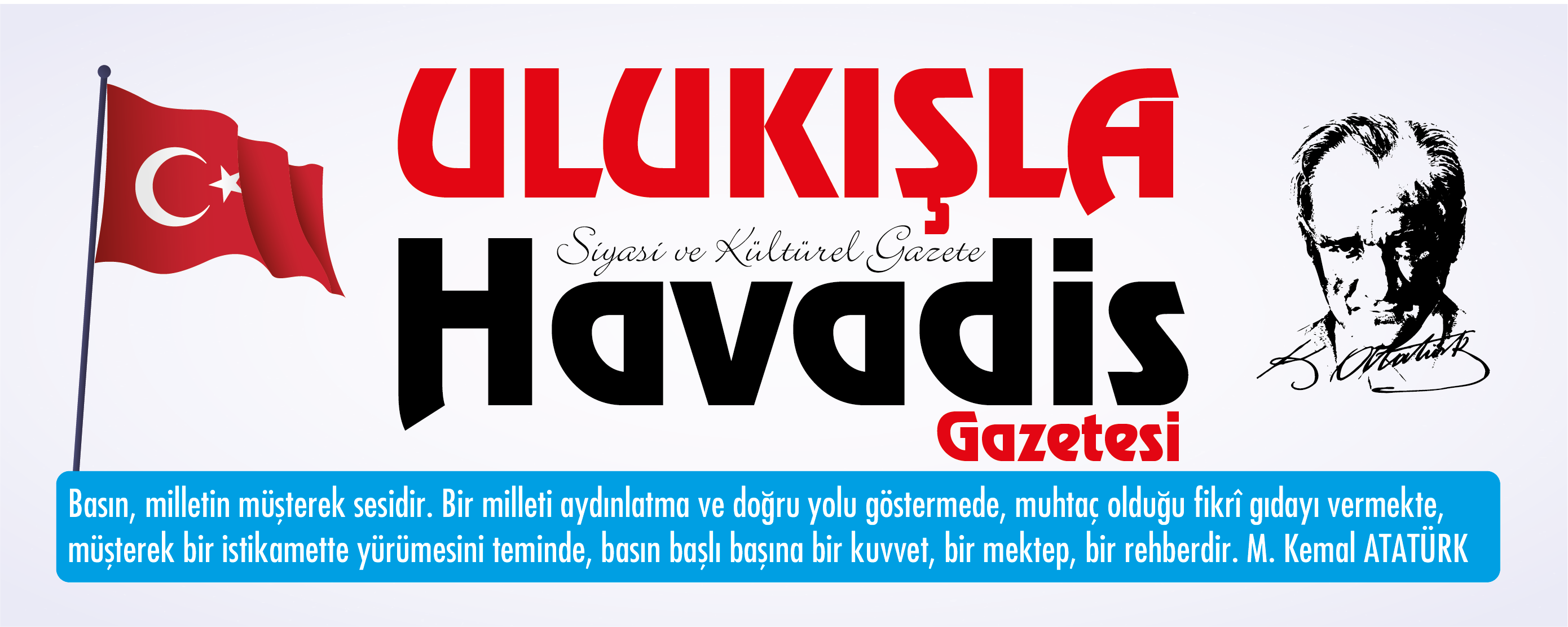
 Gürer, “Kamuya ait elde avuçta ne varsa satılıyor”
Gürer, “Kamuya ait elde avuçta ne varsa satılıyor” Gürer, “Konut satışlarında daralma devam ediyor”
Gürer, “Konut satışlarında daralma devam ediyor” Niğde’nin seçmen sayısı arttı mı?
Niğde’nin seçmen sayısı arttı mı? Gürer, “Hayvan tedavi masraflarında artış risk yaratıyor”
Gürer, “Hayvan tedavi masraflarında artış risk yaratıyor” TMO, Hayvan Üreticisine Değil Sermayeye mi Hizmet Ediyor!
TMO, Hayvan Üreticisine Değil Sermayeye mi Hizmet Ediyor! Niğdeli Taksiciden Örnek Davranış
Niğdeli Taksiciden Örnek Davranış ALTUNHİSAR’DA COVİD-19 VAKASI SIFIRLANDI!
ALTUNHİSAR’DA COVİD-19 VAKASI SIFIRLANDI! NİĞDE HALKI SAĞLIKLI SU İÇİYOR!
NİĞDE HALKI SAĞLIKLI SU İÇİYOR! Yıldız, "Tanıtım Turizmin Kalbidir!"
Yıldız, "Tanıtım Turizmin Kalbidir!" 20’Lİ YAŞLARIN KORKULU RÜYASI: YİRMİLİK DİŞ
20’Lİ YAŞLARIN KORKULU RÜYASI: YİRMİLİK DİŞ Gürer, Besici Kan Ağlıyor
Gürer, Besici Kan Ağlıyor Niğde'de Yaz Spor Okulları Açıldı
Niğde'de Yaz Spor Okulları Açıldı Özdoğan, 1500 Metrede Balkan İkincisi Oldu!
Özdoğan, 1500 Metrede Balkan İkincisi Oldu! GÖLLÜDAĞ GİZEMİNİ HÂLÂ KORUYOR!
GÖLLÜDAĞ GİZEMİNİ HÂLÂ KORUYOR! Niğde Dışladı Aksaray Sahip Çıkıyor!
Niğde Dışladı Aksaray Sahip Çıkıyor! ULUKIŞLA'YI HİÇ UNUTMADILAR!
ULUKIŞLA'YI HİÇ UNUTMADILAR! Niğde'nin Ruhunu Anlamak Gerekir!
Niğde'nin Ruhunu Anlamak Gerekir! İsviçreli Sanatçı Emelie Klein Röportajı
İsviçreli Sanatçı Emelie Klein Röportajı Karadağlı Sanatçı Marija Nikolič Röportajı
Karadağlı Sanatçı Marija Nikolič Röportajı Portekizli Sanatçı Maria Rodrigues Röportajı
Portekizli Sanatçı Maria Rodrigues Röportajı Öztürk, Niğde Outdoor Sporları İçin Bir Cennet!
Öztürk, Niğde Outdoor Sporları İçin Bir Cennet! Kanadalı Fotoğraf Sanatçısı Martin Gaudreault Röportajı
Kanadalı Fotoğraf Sanatçısı Martin Gaudreault Röportajı Hollandalı Sanatçı Ed Hanssen Röportajı
Hollandalı Sanatçı Ed Hanssen Röportajı Norveç’li Sanatçı Sinikka Elfving Röportajı
Norveç’li Sanatçı Sinikka Elfving Röportajı Prof. Dr. Sandallı, “Turizm Geliştirilmelidir!”
Prof. Dr. Sandallı, “Turizm Geliştirilmelidir!” Yeraltı ve Yerüstüne Dair
Yeraltı ve Yerüstüne Dair Niğde İçin Alternatif Yeni Lezzetler
Niğde İçin Alternatif Yeni Lezzetler Heykeltraş Çağlar'dan Göncü'ye Ziyaret
Heykeltraş Çağlar'dan Göncü'ye Ziyaret Kesikbaş Türbesi Onarıldı!
Kesikbaş Türbesi Onarıldı! Artquake-6 sergisi Niğde'de Açıldı!
Artquake-6 sergisi Niğde'de Açıldı!
